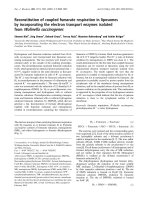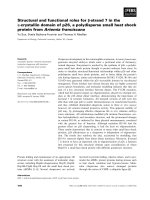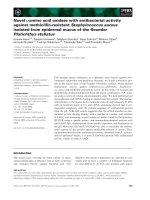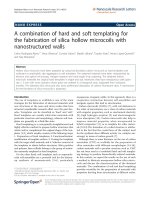evaluation the combination between bacteria isolated from gastric juice of goat and cow rumen for sugarcane bagasse hydrolysys in vitro
Bạn đang xem bản rút gọn của tài liệu. Xem và tải ngay bản đầy đủ của tài liệu tại đây (901.4 KB, 40 trang )
MINISTRY OF EDUCATION & TRAINING
CAN THO UNIVERSITY
BIOTECHNOLOGY RESEARCH & DEVELOPMENT INSTITUTE
SUMMARY
BACHELOR OF SCIENCE THESIS
THE ADVANCED PROGRAM IN BIOTECHNOLOGY
EVALUATION THE COMBINATION
BETWEEN BACTERIA ISOLATED FROM
GASTRIC JUICE OF GOAT AND COW RUMEN
FOR SUGARCANE BAGASSE
HYDROLYSYS IN VITRO
SUPERVISOR
STUDENT
MSc. VO VAN SONG TOAN
TRAN HO DIEM DOAN
Dr. HO QUANG DO
Student code: 3082507
Ass.Prof. Dr. TRAN NHAN DUNG
Session: 34 (2008- 2013)
Can Tho, 2013
APPROVAL
SUPERVISOR
MSc. VO VAN SONG TOAN
STUDENT
TRAN HO DIEM DOAN
Dr. HO QUANG DO
Ass. Prof. Dr. TRAN NHAN DUNG
Can Tho, May 2013
PRESIDENT OF EXAMINATION COMMITTEE
i
ABSTRACT
Thesis " Evaluation The Combination Between Bacteria
Isolated From Gastric Juice Of Goat And Cow Rumen For
Sugarcane Bagasse Hydrolysys In Vitro” was done to increase
the degradation of bagasse in in vitro conditions. Four bacteria
strains of goat rumen, including DD9, DD5, DD7 and DD13,
had been working together to investigate the cellulase activity.
With halo zone diameter 27mm and degraded DM rate 11.13%,
the combination between DD9 and DD7 was the most effective
treatment that was selected to make post experiments.
Sequencing results showed that the line DD9 similar to the max
identity of 94% with Bacillus subtilis RC24 and the 92% max
idetnity with Bacillus subtilis BA3_1A was the result of bacterial
strain DD7. In vitro, the combination of three lines of bovine
rumen bacteria (BM13, BM21 and BM49) and line DD9 in 1:3
ratios for the best output with DM digestibility was 21.27 %,
cellulose and hemicelluloses were 8.17% and 10.22%,
respectively.
Keywords: Bacilus subtilis, hydrolysis, in vitro, rumen
bacteria, sugarcane bagasse
ii
CONTENTS
Page
ABSTRACT ............................................................................. ii
CONTENTS ............................................................................ iii
1. INTRODUCTION ................................................................ 1
2. MATERIALS AND METHODS.......................................... 3
2.1. Materials ........................................................................ 3
2.2. Methods ......................................................................... 4
2.2.1. Studying on the components of sugarcane
bagasse… ...................................................................... 4
2.2.2. Screening of combination of 4 rumen bacteria
strains isolated from gastric juice of goat ....................... 6
2.2.3. Identification of bacteria by PCR method ............. 7
2.2.4. Studying on a combination between ruminal
bacteria isolated from gastric juice of goat and cow in
vitro ............................................................................ 10
2.3. Experiment Design and Statistical Analysis .................. 12
3. RESULTS AND DISCUSSIONS ....................................... 13
3.1. Studying on the components of sugarcane bagasse ........ 13
3.2. Screening of combination of 4 rumen bacteria strains
isolated from gastric juice of goat ........................................ 14
3.3. Identification of bacteria by PCR method ...................... 17
3.3.1. Strain DD9 ......................................................... 17
3.3.2. Strain DD7 ......................................................... 18
iii
3.4. Combination of ruminal bacteria isolated from goat and
cow in vitro condition .......................................................... 20
3.4.1. Dry matter content ............................................. 20
3.4.2. Cellulose content................................................ 21
3.4.3. Hemicellulose content ........................................ 23
3.4.4. Lignin content .................................................... 25
4. CONCLUSIONS AND SUGGESTIONS ........................... 27
4.1. Conclusions .................................................................. 27
4.2. Suggestions .................................................................. 27
iv
1. INTRODUCTION
The demands of animal protein in people diet lead to
development of the animal husbandry. Based on industrial
modernization, many households have invested large scale of
infrastructure in rural areas. Feeds are mainly base on natural
grasses and crop residues. The more the sufficient nutrients in
each diet are supplied quantity and quality, the more the
livestock productivity will increase. To improve production in
each household, many various methods for improvement of feed
utilization have been studied for several decades (Jackson,
1978).
In recent years, there has been an increasing trend
towards more efficient utilization of agro-industrial by products,
such as sugarcane bagasse, as raw material for new industrial
applications. Bagasse waste has been used in large quantities by
the sugar and ethanol industries, mainly as fuel for sugar mills.
However, the remained bagasse is still pollutant to the
environment. Thus, a suitable mean for treatment of this residue
is an important objective to be pursued.
Using microorganisms for enzymatic treatment of
sugarcane bagasse is one of prospective strategies. A large
amount of cellulase enzyme can be produced by ruminal
bacteria. In 2012, TH Truemilk factory applied successfully
using some kind of by-products of agricultural to feed beefs.
Breeding cows by sugarcane bagasse can be applied in some
countries such as Japan and Korea. Goats are ruminants with
cows but there have many more outstanding features than. Goats
1
have the ability to adapt to the harsh conditions of food and
climate. One of the reasons for that is the activity of
microorganisms in the rumen of goats (Ho Quang Do and
Nguyen Thu Thuy, 2013). To help beef enhance nutrient
absorption from food, the thesis was conducted to study the
possibility of bagasse degradation of goat rumen bacteria
combined with cow rumen bacteria in vitro conditions.
Objectives:
To select goat rumen bacterial strains that are capable to
coordinate three ruminal bacteria isolates from gastric juice of
cows in order to improve hydrolysis of bagasse in vitro
conditions.
2
2.
MATERIALS AND METHODS
2.1.
Materials
Equipments: water bath, incucell incubator (Germany),
Velp Raw Fiber Extractor (Italia), Orion 420A pH meter (USA),
Pbi-international autoclave (Germany), Rotary shaker GFL 3005
(Germany), Sequencer ABI 3130 (USA).
Chemicals: Ethanol 95%, sulfuric acid H2SO4 98%,
NaOH, acetone, sodium sulphite anhydrous (Na 2SO3), n-octanol
(C8H18O),
disodium
ethylenediaminetetraacetate
(EDTA,
C10H14N2Na2O8), sodium lauryl sulfate neutral (C12H25NaO4S),
cetryltrimethylammonium
bromide
technical
grade
(C19H42BrN), Tris-HCl (pH8), Isopropanol, Proteinase K …
Sample
Sugarcane bagasse: after collecting from Hau Giang
Sugar Factory, sugarcane bagasse were desiccated at 70ºC in
30-45 minutes, then ground by Reetsch Miill with holes 0.2mm.
Microorganism: Three bacteria including BM13,
BM21 and BM49 were isolated from rumen of cow (Do Thi
Cam Huong, 2012); and four ruminal bacteria species isolated
from goat: DD9, DD5, DD7 and DD13 (Laboratory of Enzyme
Technology).
Ruminal fluid of cow: collected at the farm, located on
Phu Thanh Town, Tra On District, Vinh Long Province.
3
2.2.
Methods
2.2.1.
Studying on the components of sugarcane bagasse
Objective:
to evaluate general of composition of
sugarcane bagasse
a) Dry matter content:
Dried crucibles for weight balance at 70ºC. Tarred and
recorded the weight of each crucible.
Added 2g sample into each crucible. Put these crucibles
with lids into preheated oven at 70ºC. Tarred and recorded the
weight of each crucible.
Calculated dry matter (DM) content:
weight of residue – weight of crucible
% DM =
x 100
weight of sample
(AOAC, 1993)
b) Hemicellulose content (Neutral Detergent FiberNDF, and Acid Detergent Fiber-ADF)
Acid Detergent Fiber-ADF
Added 100ml of acid detergent solution with 0.5 grams
of sample, and some drops of n-octanol. Heated and refluxed for
60 minutes.
Filtered and washed 3 times with boiling water, then
twice with acetone.
Dried at 70ºC and weigh them.
Calculated acid detergent fiber (ADF)
4
weight of residue
% ADF =
x 100
weight of sample
(Van Soest and Robertson, 1979)
Neutral Detergent Fiber- NDF
Added 100ml of neutral detergent solution with
0.5grams of sample, 0.5 grams of sodium sulfite and some drops
of n-octanol. Heated and refluxed for 60 minutes.
Filtered and washed 3 times with boiling water, then
twice with acetone.
Dried at 70ºC and weigh them.
Calculated neutral detergent fiber (NDF):
weight of residue
% NDF =
x 100
weight of sample
(Van Soest and Wine, 1967)
Hemicellulose content
% Hemicellulose = %NDF- %ADF
(Van Soest and Robertson, 1979)
c) Cellulose and Lignin content
Acid Detergent Lignin-ADL
Used the residue of acid detergent fiber determination.
Added 25ml of 72% sulfuric acid at room temperature
during 3 hours, stirring every hour.
5
Filtered and washed 3 times with boiling water
Dried at 70ºC and weigh them.
Calculated acid detergent lignin:
weight of residue
% ADF =
x 100
weight of sample
(Van Soest and Robertson, 1979)
Cellulose content
% Cellulose = %ADF - %ADL
(Van Soest and Robertson, 1979)
2.2.2.
Screening of combination of 4 goat rumen bacteria
strains
Objective: evaluate the sugarcane bagasse degradation
ability of mixing of 4 goat rumen bacteria
Procedure:
a) Studying the sugarcane bagasse degradation
productivity
- Injection of 5% (w/w) bacteria suspension with
7
10 CFU/ml concentration based on experiment setting.
- Bacteria were incubated in 3 days at 38ºC.
- Dried the bagasse and weigh the mass.
- Formula to definite the degradation output
6
Degradation output (%) = % DMmaterial - %DMtreatment
b) Studying the creating of halo zones in M1
medium
- 15µl bacteria solution of each treatment was spotted in
the well with 5mm diameter on M1 medium.
- The plates were incubated at 38ºC for 24 hours.
- Cellulase activity was detected by staining the plates
with Congo Red dye (0.1g/l) for 30 minutes, then washing with
NaCl 1M solution (Teather và Wood, 1981; Wood và Bhat,
1988).
- Measure the halo zone diameter (mm).
2.2.3.
Identification of bacteria by PCR method
Objective: To indentify of DNA sequences of bacterial
strains isolated from the rumen of goat.
Procedure:
A protocol for extracting genomic DNA from bacterial
cells was based on the CTAB method from Maniatis et al.
(1989). This protocol was followed:
- Bacteria were bred in 6ml LB medium for 16 hours.
- Transferred 2ml to a 2.2ml centrifuge tube and
centrifuged tubes at 13,000rpm for 10 minutes.
- Decanted the supernatant in the tube.
- Resuspended the pellet in 250μl TE 1X buffer by
repeated pipetting.
7
- Added 250μl of 1X TE buffer, 50 μl of 10% SDS and
5μl of ProteinaseK, mixed well (but gentle), and incubated 20
minutes in a water bath at 65°C.
- Added 400μl of 10% CTAB, gently mix, and
incubated at 65oC for 20 minutes.
- Added 600μl Chloroform:Isoamyl alcohol (24:1),
mixed well (but gentle), and centrifuged 13.000rpm for 10
minutes. Transferred the upper aqueous phase to new tube
(avoid interface).
- Added 600μl of isopropanol, mixed well (but gentle),
and freezed cell suspension at -20ºC for 2 hours.
- Washed DNA by 50μl of ethanol, centrifuged at
13,000rpm for 10 minutes.
- Discarded the supernatant and dried the pellet either at
45ºC by a vacuum drier. Dissolved DNA in 100μl 0.1X TE
buffer. Stored at -20ºC for further use.
PCR reaction
- The primer sequences:
8F
3’-AGAGTTTGATCCTGGCTCAG-5’
1492R 5’-GGTACCTTGTTACGACTT-3’
(Dojka et al., 1998)
The bacterial DNA was amplified by primers 8F and
1492R in the PCR reaction. The chemical composition and
cycle of the PCR reaction follow to Table 1 and Figure 1.
8
Table 1. The chemical components in the PCR
reaction
Component
Amount
Bi-H2O
12.5µl
Buffer 10X
2.5µl
MgCl2
2µl
dNTPs
4µl
Primer 1
1µl
Primer 2
1µl
Taq polymerase
0.25µl
DNA template
25µl
(*Source: Maniatis et al., 1989)
Figure 1. The cycle of PCR reaction
(*Source: Maniatis et al., 1989)
DNA sequencing
- The PCR product was sequenced by the ABI3130
genetic analyzer, an automated DNA sequencing. The sequence
was identified by using the BLASTN program and comparing
9
the gene sequences of other bacterial strains on GenBank, in
order to show the level of similarity matrix of strains.
Screening the morphology of bacteria
- The bacterial colonies were ensuring by the growing
pattern of bacteria on the plate and under microscopic
observation.
- Gram staining was tested following Cao Ngoc Điep
and Nguyen Huu Hiep (2008).
2.2.4.
Studying on combination ability of ruminal bacteria
isolated from goat and cow in vitro
Objective:
To
evaluate
generally
cellulose
degradability of combination of ruminal bacteria isolated from
goat and cow in in vitro.
Procedure:
- Preparation of ruminal fluid (cow): ruminal fluid was
collected through a permanent fistula of cow before the
breakfast. The cows were fed with 100% para grass (Brachiaria
mutica) before 1 month. The fluid was strained through four
layers of muslin cloth. The carbon dioxide was dissolved in a
solution. The solution was kept in an incubator at 38oC.
- Preparing buffer: added component of buffer solution
(Table 5) into round flat-bottomed flask. The carbon dioxide
gently bubbled into the solution until the liquid turn from
opaque to almost transparent. After 15minutes of warming in an
incubator 38oC, the ruminal fluid and buffer solution were
mixing.
10
Table 2.The compositions of buffer in vitro
Components
Amount
NaHCO3
9.80g
KCl
0.57g
CaCl2
0.04g
Na2HPO4.12H2O
9.30g
NaCl
0.47g
MgSO4.7H2O
0.12g
Cystein
0.25g
(*Source: Tilley and Terry, 1963)
- All experiments were arranged completely random
with 1 negative control, 1 positive control and 7 treatments.
With an in vitro experiment (Menke and Steingass, 1988), the
components of each treatment were followed:
11
Table 3. Components of treatments
Component
(ml)
DC-
DC+
NT1
NT2
NT3
NT4
NT5
NT6
NT7
Ruminal Fluid
40
0
40
40
40
40
40
40
40
Suspension
Cow bacteria
fluid (v/v)
0
12
12
6
6
6
3
3
3
Suspension of
DD9 (v/v)
0
0
0
6
0
3
9
0
4,5
Suspension of
DD7 (v/v)
0
0
0
0
6
3
0
9
4,5
Buffer
160
186
148
148
148
148
148
148
148
- Poured buffer solution and ruminal fluid into dark
bottle,
then
added
sugarcane
bagasse
and
bacteria.
Subsequently, clays were used to seal lip and mouth bottles
which were put in incubator at 38oC. After incubating 3 days,
the samples (sugarcane bagasse) were collected and tested their
components.
Determination: content of the ingredients of the
samples in experiments: DM, cellulose and hemicelluloses.
2.3.
Experiment Design and Statistical Analysis
Raw data were analysed by Microsoft Excel 2007 and
Statgraphic XV Software. DNA sequencing was supported by
BLASTN software. All experiments were performed in
triplicates.
12
3.
RESULTS AND DISCUSSIONS
3.1.
Studying on the components of sugarcane bagasse
According to the Table 4, dry matter of bagasse was
98.41% after drying. The result was similar to both the dry
matter given in the research of Shakweer (2003) with 94.57%
and the value of studying on bagasse of Do Thi Cam Huong
(2012) with 93.69%.
The cellulose content achieved 50.61%. This result was
likely to the result of Lu Vu Thao Vi (2012) with 56.32%
cellulose. However, the result was different with the research of
Hamissa et al. (1985) with 48,1%. Sallam et al. (2007) had the
result of cellulose content about 36.5%.
Hemicelluloses content was calculated from NDF and
ADF value. With Van Soest method, hemicellulose content
contained 29.81% in bagasse. According to researches of Lee
and Koo. (2003) and Akinfemi (2012), the hemicellulose
contents were 24% and 15.98%, respectively.
0.5grams of sugarcane bagasse were analysed by acid
detergent solution. Lignin content was 14.63%. The results of
Feng Peng et al. (2009) with 20-30% of lignin percent in
sugarcane. According to Ilindra and Dhake (2008) with 21.1%
lignin content, it was different with this lignin content of the
bagasse.
13
Table 4. The components of sugarcane bagasse
% DM
%
%
%
(m/m)
Cellulose
Hemicelluloses
Lignin
(m/m)
(m/m)
(m/m)
50.61
29.86
14.63
98.41
Due to analysis of fiber components in bagasse and
comparison with other materials, the result was determined high
cellulose and hemicelluloses, low lignin. Therefore, sugarcane
bagasse was an appropriate material to culture bacteria
synthesized cellulose and by-products in breeding.
3.2.
Screening of combination of 4 goat rumen bacteria
strains
Objective: To evaluate generally cellulase activities of
bacteria combination.
The linear equation between optimal density at 600nm
length wave and bacterial concentration of 4 goat rumen
bacteria.
Strain DD9:
y = 0,823x + 5,505
R2 = 0,987
Strain DD5:
y = 1,008x + 5,247
R2 = 0,987
Strain DD7:
y = 3,362x + 4,714
R2 = 0,996
Strain DD13:
y = 0,238x + 6,374
R2 = 0,995
Due to above equations, bacteria were isolated at
7
10 CFU/ml content.
a) The results of sugarcane bagasse degradation of 15
treatments by halo diameter method were shown in Figure 2.
14
Treatments 1, 2, 3 and 4, contained only one bacteria strain, had
smaller diameter than in combination of ruminal bacteria.
Treament 6 was the most efficient treatment of cellulase
activities with 27mm of diameter value, had a statistically
significant difference of 5 % value with the others, except
treatment 10 and treatment 15. According to Li-Jung et al.
(2010), exoglucanase activity was determined by incubation of
bacterial solution in cellulose material. Therefore, NT6 being
contented strain DD9 and DD7 had strong exoglucanase
activity.
15
Figure 2.
Halo diameter values
of combination
treatments
*NT1: 1; NT2: 2; NT3: 3; NT4: 4; NT5: 1 + 2; NT6: 1 + 3; NT7: 1 +
4; NT8: 2 + 3; NT9: 2 + 4; NT10: 3 + 4; NT11: 1 + 2 + 3; NT12: 1 + 2 + 4;
NT13: 1 + 3 + 4; NT14: 2 + 3 + 4; NT15: 1 + 2 + 3 + 4.
*1: DD9, 2: DD5, 3: DD7 and 4: DD13
*Values are the average of three replicates, and means within columns
with different superscript letters are statistically significant difference at a 5%
level, and vice versa, %CV = 12.03%
b) Results on the dry matter content of bagasse were
shown in Figure 3. It showed that treatment 6 (NT6) had high
digestibility of sugarcane bagasse. As a result, DD9 and DD7
strains were identified by PCR method and DNA Sequencing of
16S rRNA gene.
16
Figure 3: Dry matter content of bagasse
*NT1: 1; NT2: 2; NT3: 3; NT4: 4; NT5: 1 + 2; NT6: 1 + 3; NT7: 1 +
4; NT8: 2 + 3; NT9: 2 + 4; NT10: 3 + 4; NT11: 1 + 2 + 3; NT12: 1 + 2 + 4;
NT13: 1 + 3 + 4; NT14: 2 + 3 + 4; NT15: 1 + 2 + 3 + 4.
*1: DD9, 2: DD5, 3: DD7 và 4: DD13
*Values are the average of three replicates, and means within columns
with different superscript letters are statistically significant difference at a 5%
level, and vice versa, %CV = 9.08%
3.3.
Identification of bacteria by PCR method
3.3.1.
Strain DD9
Molecular
analysis
based
on 16S
rRNA gene
sequencing reveals that strain DD9 was maximum identity of
94% with FJ263368.1 Bacillus subtilis strain RC24.
DNA sequencing of DD9
5’GCTTGAAAGGGGACGAAAAAGGCGGAGGGG
TGTGTGGGCGTGGGTAACCTGCCTGTAAGAGAGGAAA
AAGGAGCGGGAAACCGGGGCTAATACCGGATGGTTGT
TTGAACCGCATGGTTCAAACAAAACGGCGGCTTAGGC
17
TACCACTTACAGATGGACCCGCGGCGCATTAGCTAGTT
GGTGAGGTAACGGCTCACCAAGGCAACGATGCGTAGC
CGACCTGAGAGGGTGATCGGCCACACTGGGACTGAGA
CACGGCCCAAACTCCTACGGGAGGCAGCAGTAGGGAA
TCTTCCGCAATGGACGAAAGTCTGACGGAGCAACGCC
GCGGGGAGTGATGTTGGTTTTCGGATCGTAAAGCTCTG
TTGTTAGGGAAGAACAAGTACCGTTCAAATAGGGCGG
TATCTTGAAGGTACCTAACCAAAAAAGCCACGGCTAA
CTACGTGCCAACAGCCGGGGGTAATACGTA3’
Figure 4. The result of 16S rRNA sequencing strain
DD9
According to Nakano and Zuber (1998), Bacillus
subtilis had rod-shape and Gram positive. Bacillus subtilis were
isolated from rumen of cows (Microbial, 1999). They can
produce cellulase enzyme at 40ºC with highest amount.
In the morphology, DD9 is a Gram-positive bacteria,
rod-shape, irregular, raised, erode and milky white colony. The
result was similar to research of Perez et al. (2000).
3.3.2.
Strain DD7
Searching on BLAST of NCBI showed that strain DD7
was found to be closely related to Bacillus subtilis strain
BA3_1A with high homology (92%).
18









